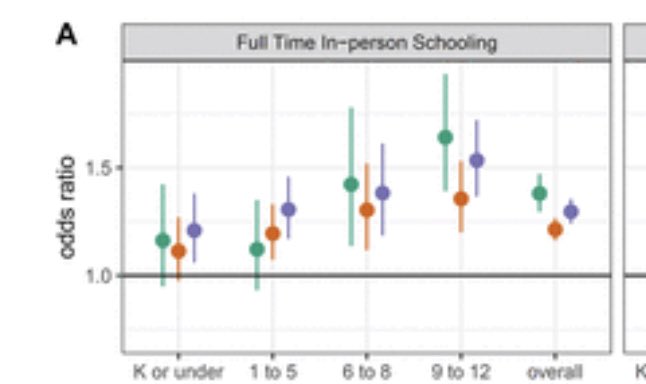1/ New #COVID19 #K12 paper in @ScienceMagazine: the part that most excites me is zooming in on the safety measures that best predict low #COVID19 risks...
https://science.sciencemag.org/content/early/2021/04/28/science.abh2939">https://science.sciencemag.org/content/e... https://twitter.com/JustinLessler/status/1387842131629207552">https://twitter.com/JustinLes...
https://science.sciencemag.org/content/early/2021/04/28/science.abh2939">https://science.sciencemag.org/content/e... https://twitter.com/JustinLessler/status/1387842131629207552">https://twitter.com/JustinLes...
2/ Parents & school staff & community members really want to know: What is most important? What measures should be prioritized at my school? This paper models that in detail: results reinforce findings from previous work https://twitter.com/justinlessler/status/1387842126692507650">https://twitter.com/justinles...
3/ importance of extracurriculars consistent with a lot of what’s seen in contact tracing of #K12 outbreaks - it’s usually not the classroom contact; it’s the less regulated extracurricular time.
4/ importance of teacher masking also fits the literature: in many different kinds of studies, adults are riskiest for transmission
5/ Daily symptom checks is also a really interesting one. Bc kids’ symptoms can be non-specific, wasn’t clear how valuable this is. This is really strong evidence that the daily symptom checks (my family do paper form at daycare, apps for K) matter...
6/ There could be all kinds of mechanisms at play here (including proxy for district commitment to safety practices and access to expert advice), but it seems worth keeping around.
9/ But maps from the paper are a great display about how geographically patterned #K12 in-person schooling & mitigation were: in the bizarro-world way that defines a lot of local #COVID19 policy, places that were more “open” also more likely to use fewer safety measures
11/ results might differ in this half-vaxxed era in US. My guess: a much wider spread in family risk from K12, with practically 0 risk in some communities but maybe higher risk in places with lots of community & teacher resistance to vaccination + relaxation of safety measures
* note: Anyone who lumps all preschool & K12 into one bucket is not being evidence-based. Extra side-eye if they also lump in university students

 Read on Twitter
Read on Twitter
 14/ Another finding hat’s consistent w previous research is lower risk from younger kids than older #K12 students* note: Anyone who lumps all preschool & K12 into one bucket is not being evidence-based. Extra side-eye if they also lump in university students https://abs.twimg.com/emoji/v2/... draggable="false" alt="😒" title="Unerfreutes Gesicht" aria-label="Emoji: Unerfreutes Gesicht">" title="https://abs.twimg.com/emoji/v2/... draggable="false" alt="🧵" title="Thread" aria-label="Emoji: Thread">14/ Another finding hat’s consistent w previous research is lower risk from younger kids than older #K12 students* note: Anyone who lumps all preschool & K12 into one bucket is not being evidence-based. Extra side-eye if they also lump in university students https://abs.twimg.com/emoji/v2/... draggable="false" alt="😒" title="Unerfreutes Gesicht" aria-label="Emoji: Unerfreutes Gesicht">" class="img-responsive" style="max-width:100%;"/>
14/ Another finding hat’s consistent w previous research is lower risk from younger kids than older #K12 students* note: Anyone who lumps all preschool & K12 into one bucket is not being evidence-based. Extra side-eye if they also lump in university students https://abs.twimg.com/emoji/v2/... draggable="false" alt="😒" title="Unerfreutes Gesicht" aria-label="Emoji: Unerfreutes Gesicht">" title="https://abs.twimg.com/emoji/v2/... draggable="false" alt="🧵" title="Thread" aria-label="Emoji: Thread">14/ Another finding hat’s consistent w previous research is lower risk from younger kids than older #K12 students* note: Anyone who lumps all preschool & K12 into one bucket is not being evidence-based. Extra side-eye if they also lump in university students https://abs.twimg.com/emoji/v2/... draggable="false" alt="😒" title="Unerfreutes Gesicht" aria-label="Emoji: Unerfreutes Gesicht">" class="img-responsive" style="max-width:100%;"/>


